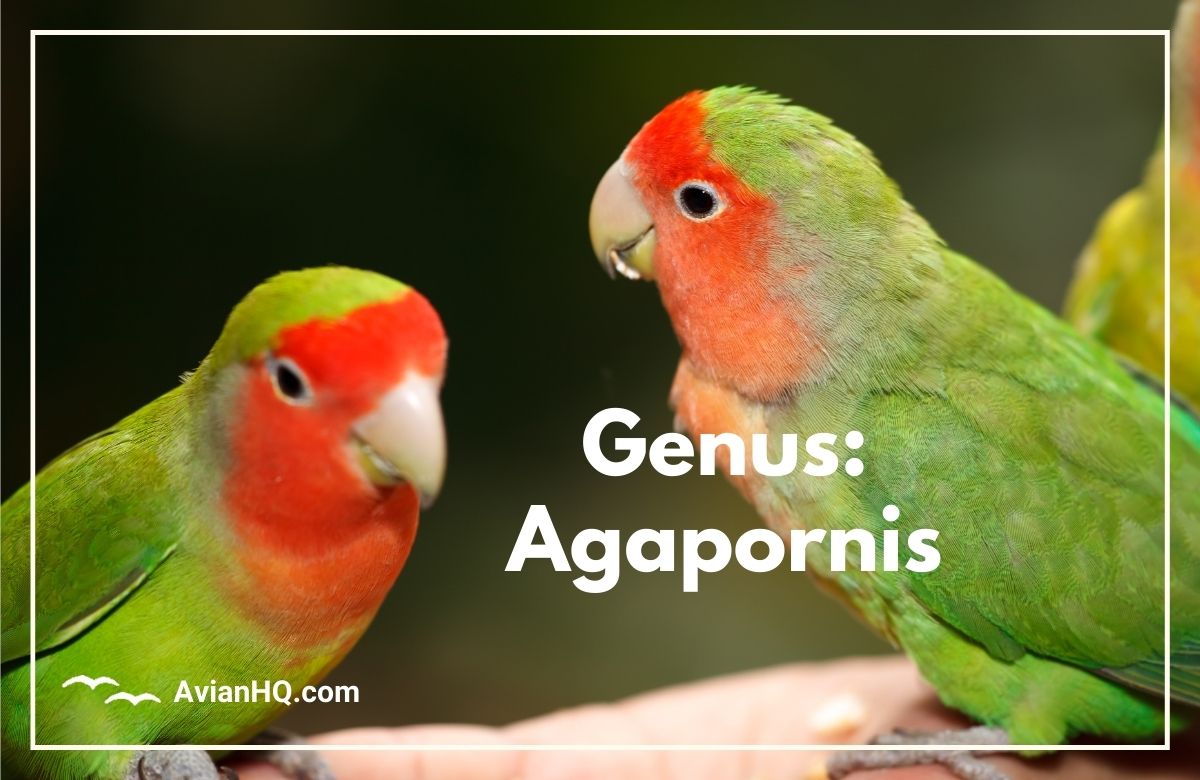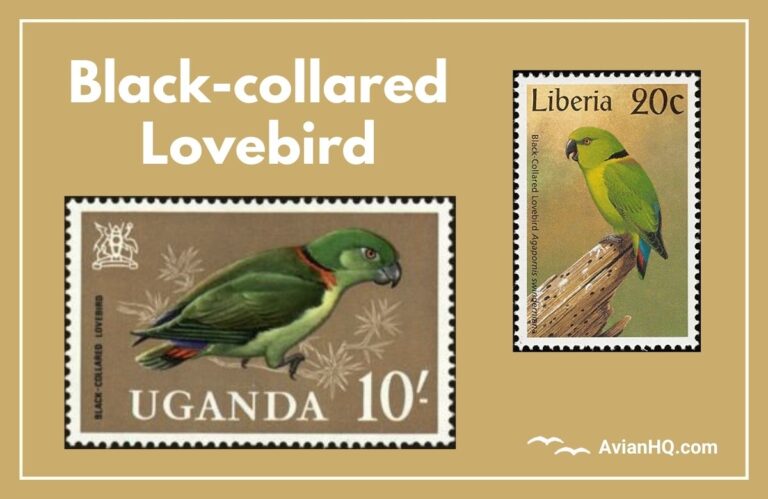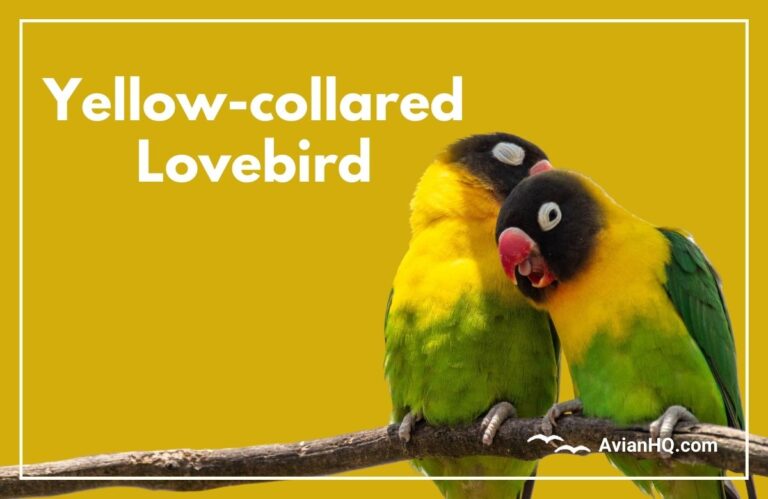Genus: Agapornis
You’ve probably seen images of cute, colorful little parrots snuggled up together, often accompanied by phrases about love and bonding. These are Agapornis lovebirds, a genus of small African parrots known for forming close, affectionate relationships with each other.
The name “lovebird” refers to the strong, monogamous pair bonding these birds display. Lovebirds use various vocalizations and physical gestures to communicate, helping maintain the social connections vital to them. When kept as pets, they can also form strong attachments to their human caretakers.
There are 9 species of Agapornis lovebirds found across the African continent. In the wild, they live in small flocks and feed mainly on fruit, vegetables, seeds and grain. Their average lifespan is 10-12 years.
In this post, you’ll learn more about:
- The 9 lovebird species and their identification
- Lovebird behavior patterns and intelligence
- Their significance both in captivity and their native habitat
- Conservation efforts to protect wild populations
We’ll spotlight what makes each species unique. You’ll also get an inside look at why lovebirds make endearing, playful companion parrots when properly cared for. However, their specialized needs also warrant some words of caution.
“Lovebirds are among the most affectionate and loyal of small parrots.”
Let’s dive in and unravel the secrets behind these iconic little birds! Their popularity arises in part from how they showcase the joy of bonding not just with a mate but with humans.
Species Spotlights
Lovebirds may seem visually similar at first glance, but the 9 species have distinct traits. Let’s briefly introduce each one:
Agapornis canus (Grey-headed Lovebird)
- Native to the island of Madagascar
- The smallest Agapornis species at 13 cm (5 inches) long
- Sexual dimorphism – males have gray heads/necks, females are green
- Quiet and peaceful disposition
Agapornis fischeri (Fischer’s Lovebird)
- 14 cm (5.5 inches) long
- Bright orange face/upper body, green wings, blue rump
- Native to north and central Tanzania
- Very popular as pets
Agapornis lilianae (Lilian’s Lovebird)
- 13 cm (5 inches) long
- Mostly green with an orange head
- Endemic to southern Malawi in Africa
- Closely related to Fischer’s lovebird
Agapornis nigrigenis (Black-cheeked Lovebird)
- 14 cm (5.5 inches) long
- Distinct black cheeks and throat
- Some red on forehead and orange upper chest
- Native to northern Zambia
Agapornis personatus (Yellow-collared Lovebird)
- 14 cm (5.5 inches) long
- Yellow neck and breast, green wings
- Blue lower back and tail feathers
- Found in Tanzania in small flocks
Agapornis pullarius (Red-headed Lovebird)
- 15 cm (6 inches) long
- Mostly green with vibrant red coloration on face and head
- One of the most widespread lovebirds in Africa
- Sexual dimorphism – males have darker red hues
Agapornis roseicollis (Rosy-faced Lovebird)
- 17-18 cm (6.5-7 inches) long
- Distinctive green and pink plumage
- Blue patch on rump
- Extremely popular aviculture species
Agapornis swindernianus (Black-collared Lovebird)
- 13.5 cm (5 inches) long
- Collar with black upper border on hindneck
- Otherwise mostly green in color
- Native to forests and savannas of central Africa
Agapornis taranta (Black-winged Lovebird)
- 16.5 cm (6.5 inches) long
- Males have vivid red foreheads and some black flight feathers
- Found at high mountain elevations in Eritrea/Ethiopia
- Feeds on juniper berries in the wild
Behavior and Intelligence
Lovebirds showcase very social behavior, akin to many fellow parrot species. Understanding their patterns provides insight into properly caring for them as pets too.
Flocking Dynamics
In the wilderness, lovebirds live in small groups called flocks. A flock often consists of 5 to 30 birds who travel, feed, roost, and bathe together. Certain lovebird species also nest in loose colonies.
They utilize a range of vocalizations to maintain contact and coordinate movements as a flock. Their high-pitched calls can travel long distances. Quieter chirps and gestures help with close interactions.
Strong Pair Bonds
Within a flock, monogamous male-female pairs form. They tend to have lifelong relationships. Paired lovebirds engage in bonding behaviors like feeding and preening each other.
Lovebird pairs also readily defend their nesting areas from intrusions by other birds. But they otherwise remain social within the broader flock.
Captivating Companions
When habituated to people, lovebirds focus much of this natural affiliation and loyalty onto their human caretakers. They love to climb all over their preferred people, explore surroundings together, and even “chat.”
Providing lovebirds a texture and activity rich environment enriches the bond further. They delight in shredder toys to chew through, swings and ladders, treat puzzles, and more. But leaving them alone for long periods risks boredom and stress.
Lovebirds display a playful intelligence. However, only a few individuals actually learn to mimic substantial human speech. Chirping a few words or sounds is more common. Their smarts definitely emerge though in navigating their environment and interacting with beloved owners.
Cultural Significance
Lovebirds have captivated people for more than just their endearing bonds and personalities. Selective breeding and escaped pets have also influenced their modern cultural imprint in subtle ways.
Aviculture Favorites
Many lovebird species breed readily in captivity. Aviculturalists have selectively bred color mutations like white, blue, yellow/orange, silver, and olive variations.
The peach-faced lovebird for example exhibits a vibrant green and pink wild-type plumage. But breeders have developed over 100 distinct color mutations! Similar diversity arises in other popular species, prized for their decorative look.
Colonizing New Habitats
Breeders often sell surplus lovebirds as pets and some owners accidentally or intentionally release them. Feral colonies of escaped lovebirds exist in cities like Nairobi and Phoenix. Hybridization between species also occurs.
These out-of-Africa populations mingle with native birds around backyard feeders and farms in their adopted lands. Their adaptability lets the lovebird diaspora gain an unexpected foothold when given the chance.
Fun Historical Trivia
The ancient Egyptians depicted lovebirds in hieroglyphics and furnishing carvings, captivated by their small size and intimacy. Some suggest they symbolized inspiration between lovers and pharaohs regarded them highly.
Threats and Conservation
In the wild, Agapornis lovebirds face several threats putting pressure on various populations:
Habitat Loss
Conversion of savannas and forests for agriculture threatens native lovebird habitats in Africa. For example, the yellow-collared lovebird resides in a Tanzanian national park but lost almost 50% of adjacent suitable breeding areas since the 1990s.
Other species like the Madagascar lovebird deal with heavy deforestation. Ensuring preserved nature zones helps counter habitat declines.
Wild Capture
The pet trade prompts substantial trapping of some lovebirds every year for export. Fischer’s lovebirds get heavily targeted, with possibly 10,000+ taken from Tanzania annually in the late 1900s.
Setting capture quotas and enforcement help prevent overexploitation of wild birds. Captive breeding also supplies more ethical alternatives.
Predators and Competition
Natural predators like snakes and birds of prey keep lovebird populations in check ecologically. But habitat loss also exposes them more to such dangers and resource pressure from other birds.
Maintaining intact ecosystems balances out these control dynamics. Supplemental feeding and boxes may also aid small or recovering flocks.
Conservation Status
The IUCN Red List catalogs:
- 5 Least Concern lovebird species
- 3 Near Threatened
- 1 Vulnerable – Madagascar lovebird
Governments and non-profits like the World Parrot Trust coordinate conservation initiatives for vulnerable Agapornis species.
Conclusion
Lovebirds earn their symbolic moniker through the strong social bonds and affection central to their flocking way of life. The 9 species display subtle differences but all share an intrinsically playful, smart, and chatty personality.
Keeping lovebirds as pets lets people enjoy DIRECTLY experiencing how companion parrots focus bonding instincts onto human caretakers. However, their specialized needs do warrant thoroughly understanding their behavior and disposition too.
In the wild, preserving their native habitat proves key to conservation efforts. This protects vulnerable lovebirds from excessive trapping, competition and predators. Supporting ethical captive breeding also aids sustainability.
From whispy head feathers to fluffy rumps, charming lovebirds showcase that small packages can have BIG appeal. Their virtues outsize their miniature builds. And evidenced by escaped populations, they easily claim a lasting place in many hearts and landscapes when given the opportunity.








Can’t thank you enough for this! 💖